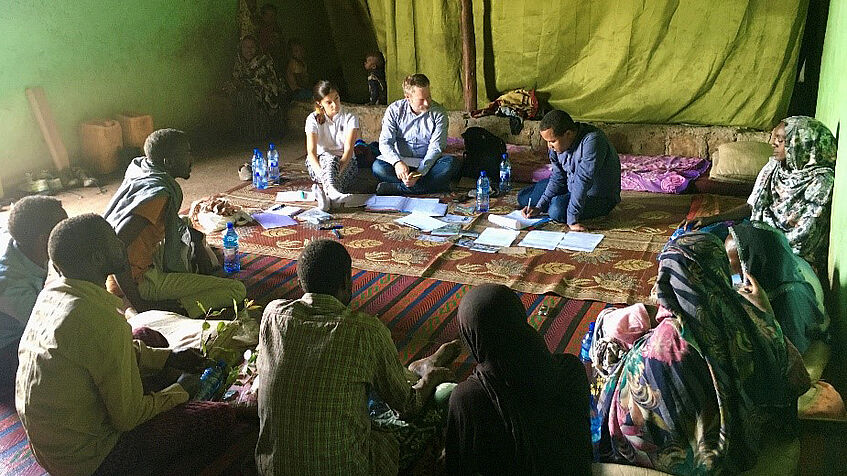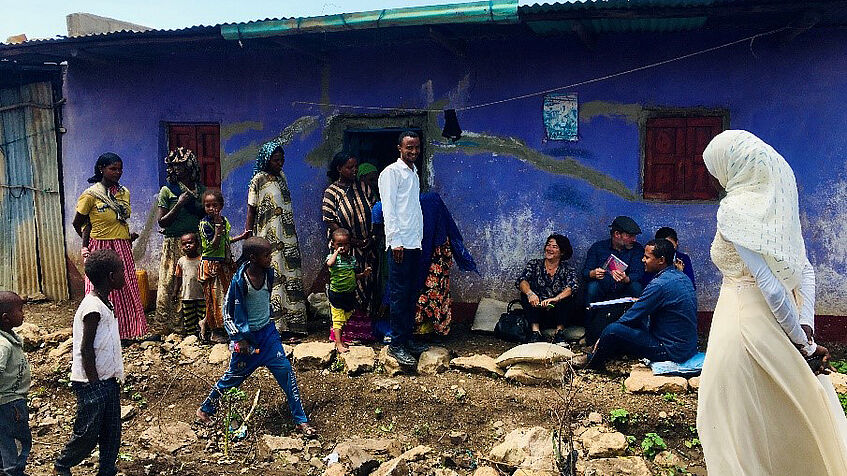Migration behavior and adaptation mechanisms of vulnerable populations – Fieldwork in Kersa (Ethiopia)
The research cooperation between Haramaya University and the University of Vienna established by Dr. Nega Assefa and Dr. Merga Dheresa from the College of Health & Medical Sciences and Dr. Marion Borderon from the Department of Geography and Regional Sciences is celebrating its fifth year of existence. The research activities of the EU-funded project AGRUMIG, the FGGA postdoc award and the PhD project of Coline Garcia have initiated the research cooperation of the two teams on the links between migration, well-being and climate change in Kersa East Hararghe, Ethiopia.
Three intensive weeks of fieldwork carried out by a multilingual and interdisciplinary team - public health experts, geographers, mathematician - have just been completed in Kersa Woreda. Inhabitants of three kebeles (kebeles are clusters of about 1200 households) have been interviewed to add depth to a quantitative study performed with the Kersa Health Demographic Surveillance System (HDSS) data on the migration-environment nexus. The choice of the sample of these three kebeles (Walta Bilisuma, Kersa and Adele Key Key) has been a direct output of this first research where the trajectory of all individuals and households of 12 kebeles over a period of 10 years has been examined. By modelling the migration behaviour of those individuals, particularly during the severe drought episode of 2015, it has been found that:
- Drought negatively affects women's mobility.
- After a large-scale drought, male labour migration decreases.
- Poor capabilities and low satisfaction suggest a high risk of involuntary immobility.
- In-situ adaptation such as irrigation are associated with lower levels of migration.
This work has raised questions and hypotheses on the processes underlying these observations, especially on the adaptation mechanisms of the most vulnerable populations during consecutive and multiple crises and their capacity and aspirations related to different types of mobility and migration.
Through interviews and Focus Group Discussions (FDGs), we have thus sought to better understand the livelihoods trajectories of families, their means of coping with the multiple crises they have experienced in recent years (inflation, multiple environmental disasters, including recurrent droughts, locust invasions, and unstable political and security situations) and their aspirations and capacity to migrate. In a context of acute food insecurity for the most disadvantaged populations, we have listened carefully to the everyday difficulties they face and their concerns and hopes for the future.
Together with the HDSS data, the material collected from the 6 FGDs and the 27 interviews that were conducted will complement the research and contribute to give meaning to the phrase "combinations of contexts" by disentangling the multiple factors and circumstances that can explain the (im)mobility behaviours of individuals & their families and their ability to cope with climatic shocks.
This joint endeavour will therefore allow us to conduct mixed-methods research made of mathematical modelling applied to the HDSS data and rich qualitative material collected in the same studied region. We thank all the participants of this human adventure full of emotions, especially Abebe, Elias and Yenene, for their patience and professionalism in the field and all the families and individuals who welcomed us warmly and graciously agreed to answer all our questions.
The UNIVIE team Harald, Simon, Coline, Marion & Laurence from AMU




